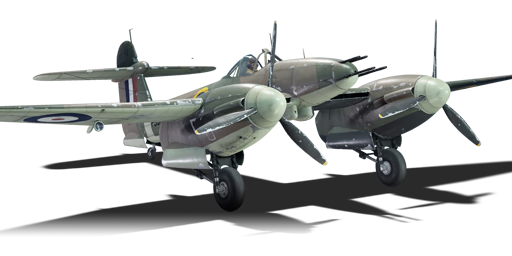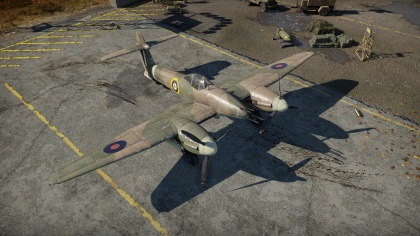Whirlwind Mk I
Contents
| This page is about the British twin-engine fighter Whirlwind Mk I. For the other version, see Whirlwind P.9. |
Description
The Whirlwind Mk I is a rank British twin-engine fighter
with a battle rating of (AB), (RB), and (SB). This aircraft was introduced in Update 1.75 "La Résistance".
General info
Flight Performance
Describe how the aircraft behaves in the air. Speed, manoeuvrability, acceleration and allowable loads - these are the most important characteristics of the vehicle.
| Characteristics | |||||||
|---|---|---|---|---|---|---|---|
| Stock | |||||||
| Max Speed (km/h at 4,877 m) |
Max altitude (meters) |
Turn time (seconds) |
Rate of climb (meters/second) |
Take-off run (meters) | |||
| AB | RB | AB | RB | AB | RB | ||
| 559 | 543 | 24.2 | 25.2 | 12.2 | 12.2 | 650 | |
| Upgraded | |||||||
| Max Speed (km/h at 4,877 m) |
Max altitude (meters) |
Turn time (seconds) |
Rate of climb (meters/second) |
Take-off run (meters) | |||
| AB | RB | AB | RB | AB | RB | ||
| 607 | 580 | 21.7 | 23.0 | 21.3 | 15.0 | 650 | |
Details
| Features | ||||
|---|---|---|---|---|
| Combat flaps | Take-off flaps | Landing flaps | Air brakes | Arrestor gear |
| ✓ | ✓ | ✓ | X | X |
| Limits | ||||
|---|---|---|---|---|
| Wing-break speed (km/h) |
Gear limit (km/h) |
Combat flaps (km/h) |
Max Static G | |
| + | - | |||
| 490 | ~10 | ~5 | ||
| Optimal velocities | |||
|---|---|---|---|
| Ailerons (km/h) |
Rudder (km/h) |
Elevators (km/h) |
Radiator (km/h) |
| < 420 | < 420 | < 450 | > 324 |
| Compressor (RB/SB) | ||
|---|---|---|
| Setting 1 | ||
| Optimal altitude | 100% Engine power | WEP Engine power |
| 4,575 m | 885 hp | 946 hp |
Survivability and armour
- 60 mm Bulletproof glass in cockpit front.
- 9 mm Steel plates in the nose.
- 4 mm Steel plate in pilot’s seat.
- 6 mm Steel plate behind the pilot.
Armaments
Offensive armament
The Whirlwind Mk I is armed with:
- 4 x 20 mm Hispano Mk.I cannons, nose-mounted (60 rpg = 240 total)
Suspended armament
The Whirlwind Mk I can be outfitted with the following ordnance:
- 2 x 250 lb G.P. 250 lb Mk.IV bombs (500 lb total)
- 2 x 500 lb G.P. 500 lb Mk.IV bombs (1,000 lb total)
Usage in battles
Describe the tactics of playing in an aircraft, the features of using vehicles in a team and advice on tactics. Refrain from creating a "guide" - do not impose a single point of view, but instead, give the reader food for thought. Examine the most dangerous enemies and give recommendations on fighting them. If necessary, note the specifics of the game in different modes (AB, RB, SB).
Manual Engine Control
| MEC elements | ||||||
|---|---|---|---|---|---|---|
| Mixer | Pitch | Radiator | Supercharger | Turbocharger | ||
| Oil | Water | Type | ||||
| Controllable | Controllable Not auto controlled |
Controllable Auto control available |
Controllable Auto control available |
Separate | Not controllable 1 gear |
Not controllable |
Modules
| Tier | Flight performance | Survivability | Weaponry | ||
|---|---|---|---|---|---|
| I | Fuselage repair | Radiator | Offensive 20 mm | SBC mk.II | |
| II | Compressor | Airframe | |||
| III | Wings repair | Engine | New 20 mm cannons | MBC mk.II | |
| IV | Engine injection | Cover | |||
Pros and cons
Pros:
- Devastating nose-mounted 20mm Hispano armament.
- Great for head-ons.
- Good turn rate when upgraded for a twin engined fighter.
- able to carry bombs, unlike P.9 Variant
Cons:
- Poor climb rate.
- Under-powered engines.
- Drum-fed Hispano Mk1s. Only 60 rounds per gun. You must make every round count.
- Inaccurate Hispano Mk1 cannons. Precise aiming is hard.
- Poor roll rate
- Quite slow level flight speed
- Unfavorable matchmaking puts you up against some very challenging opponents
History
The Westland Whirlwind was designed after a specification was issued by the British Air Ministry. The specification called for a cannon-armed day and night fighter. The Air Ministry wanted a top speed of at least 530 km/h at an altitude of 4,600m. Out of five designs offered by the companies. The Air Ministry decided to go with Westland's design for several important reasons. The cannon was mounted on the nose so that the recoil does not affect the accuracy of the gun. There were also no convergence problem as compared to other single-engine fighters with wing mounted guns. The requirements also led to the world's first bubble canopies on a plane. However the decision to arm the Spitfire with cannon and the development of other twin engine fighters such as the Bristol Beaufighter has led Fighter Command to use the Whirlwind less and less as the war progressed. The first batch of Rolls-Royce Peregrine engines were also delayed. It was also found that the engine was severely under-powered and the drum magazines used to feed the cannons were small in capacity. All of this has resulted in the Whirlwind's cancellation and resulted in the plane only equipping two RAF squadrons.
Media
Excellent additions to the article would be video guides, screenshots from the game, and photos.
See also
Links to the articles on the War Thunder Wiki that you think will be useful for the reader, for example:
- reference to the series of the aircraft;
- links to approximate analogues of other nations and research trees.
External links
Paste links to sources and external resources, such as:
- topic on the official game forum;
- encyclopedia page on the aircraft;
- other literature.
| Britain strike aircraft | |
|---|---|
| Blackburn | Firebrand TF Mk IV · Firecrest |
| Bristol | Beaufighter Mk I (40-mm) · Beaufighter Mk VIc · Beaufighter Mk X · Beaufighter Mk 21 |
| CAC | ▄Wirraway |
| Fairey | Firefly F Mk I · Firefly FR Mk V |
| de Havilland | Mosquito FB Mk VI · Mosquito FB Mk XVIII |
| Hawker | Hurricane Mk IV · Tempest Mk V (Vickers P) |
| Westland | Wyvern S4 |





